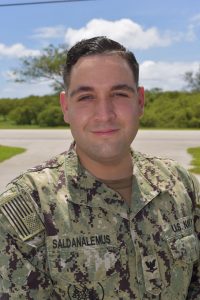A 2013 Mar Vista High School graduate and Imperial Beach native builds and fights around the world as a member of a naval construction battalion center located on the island of Guam.

Petty Officer 3rd Class Antonio Saldanalemus is an electronics technician with the 30th Naval Construction Regiment.
A Navy electronics technician is responsible for operating and managing electronics systems.
Saldanalemus credits success in the Navy to many of the lessons learned in Imperial Beach. “I was in ROTC and I learned that when people tell you that you can’t do something that should just motivate you more,” said Saldanalemus.
The jobs of some of the Seabees today have remained unchanged since World War II, when the Seabees paved the 10,000-mile road to victory for the allies in the Pacific and in Europe.
Since 1942 Seabees have served in all American conflicts. They have also supported humanitarian efforts using their construction skills to help communities around the world. They aid following earthquakes, hurricanes and other natural disasters.
According to officials at the U.S. Navy’s Pacific Fleet headquarters in Pearl Harbor, Hawaii, the ships, submarines, aircraft and Navy personnel forward-deployed to Guam are part of the world’s largest fleet command and serve in a region critical to U.S. national security. The U.S. Pacific Fleet encompasses 100 million square miles, nearly half the Earth’s surface, from Antarctica to the Arctic Circle and from the West Coast of the United States into the Indian Ocean. All told, there are more than 200 ships and submarines, nearly 1,200 aircraft, and more than 130,000 uniformed and civilian personnel serving in the Pacific.
“At the task force, I get the chance to see a lot of different missions and support different tasks that I wouldn’t normally get to experience in my job field,” Saldanalemus said.
Though there are many ways for sailors to earn distinction in their command, community, and career, Saldanalemus is most proud of recently completing the qualification to wear the Expeditionary Warfare Device.
“It carries a lot of weight with our command and I put a lot of hard work into it,” Saldanalemus said.
Serving in the Navy means Saldanalemus is part of a world that is taking on new importance in America’s focus on rebuilding military readiness, strengthening alliances and reforming business practices in support of the National Defense Strategy.
A key element of the Navy the nation needs is tied to the fact that America is a maritime nation, and that the nation’s prosperity is tied to the ability to operate freely on the world’s oceans. More than 70 percent of the Earth’s surface is covered by water; 80 percent of the world’s population lives close to a coast; and 90 percent of all global trade by volume travels by sea.
“Our priorities center on people, capabilities and processes, and will be achieved by our focus on speed, value, results and partnerships,” said Secretary of the Navy Richard V. Spencer. “Readiness, lethality and modernization are the requirements driving these priorities.”
As a member of one of the U.S. Navy’s most relied upon assets, Saldanalemus and other sailors know they are part of a legacy that will last beyond their lifetimes, one that will provide a critical component of the Navy the nation needs.
“Serving in the Navy is about doing something for the greater good and serving the nation,” Saldanalemus said. “I’m doing something that’s bigger than myself.”




